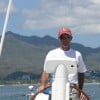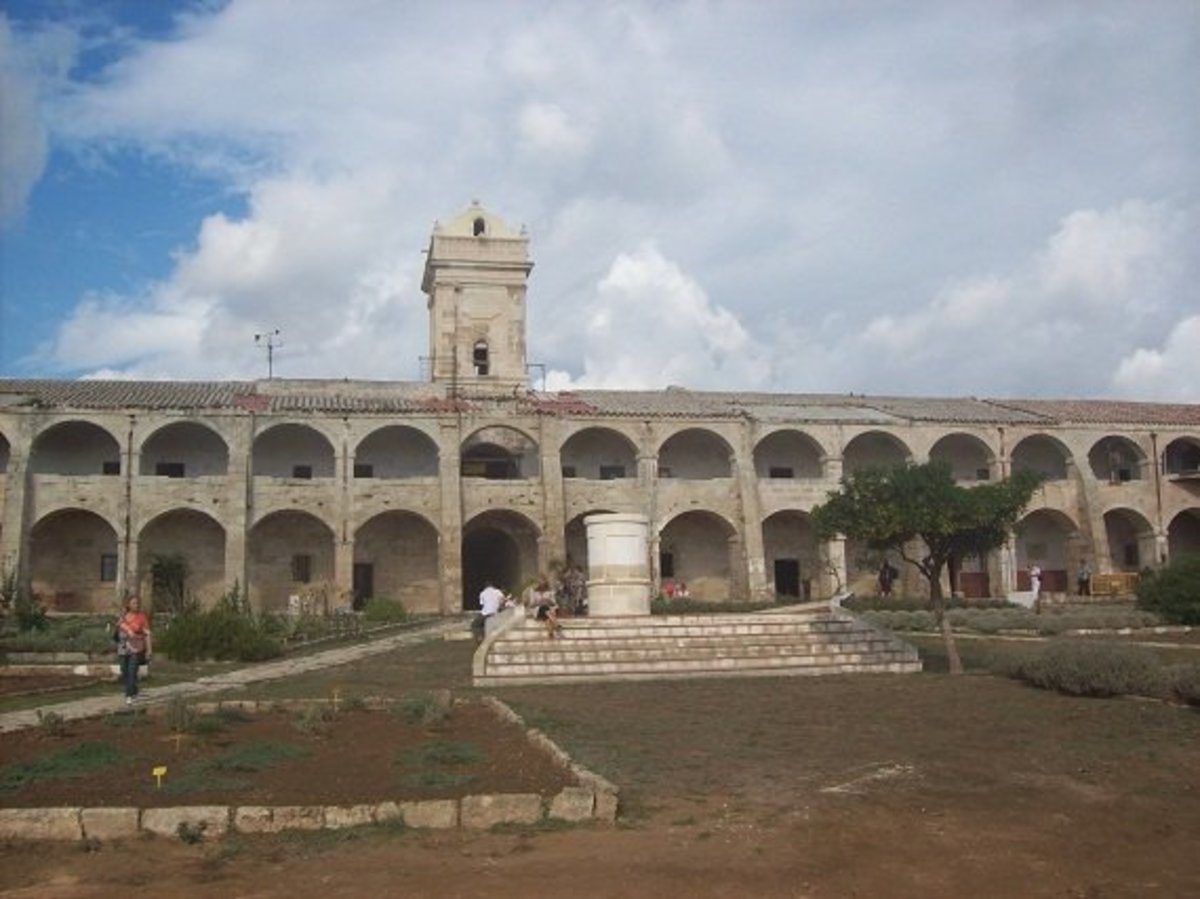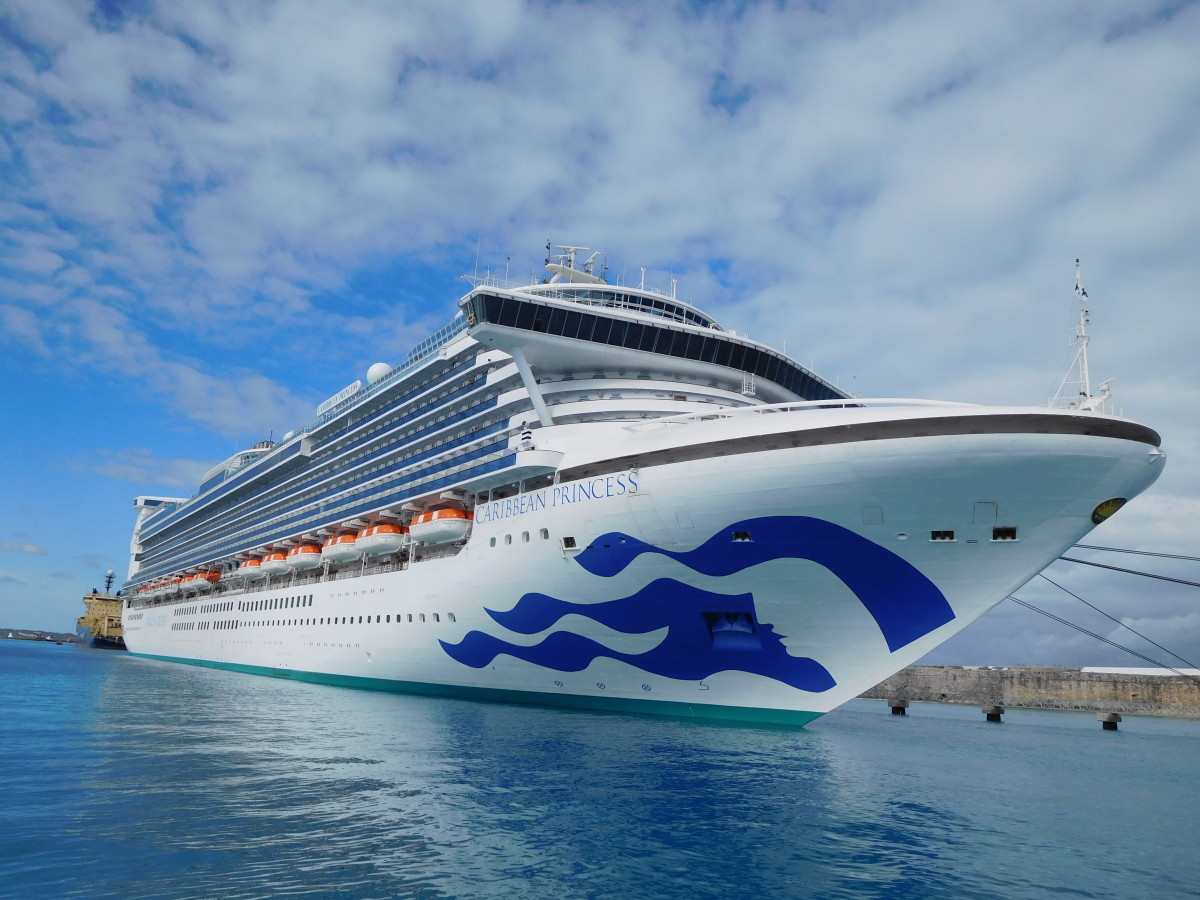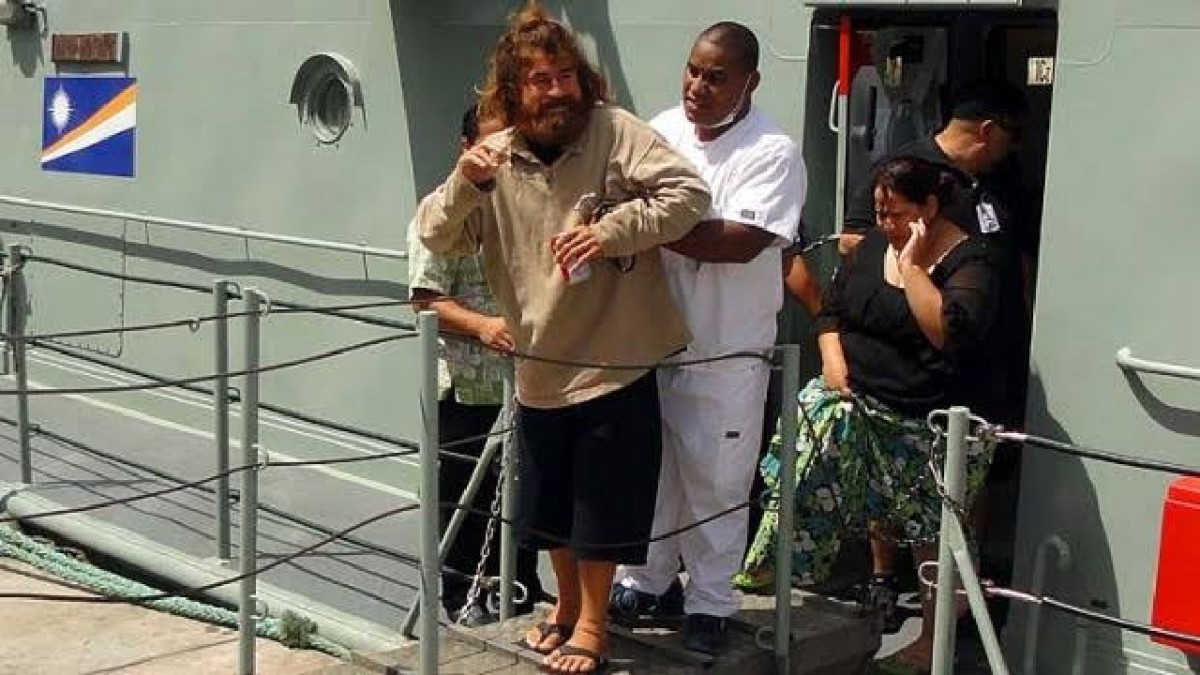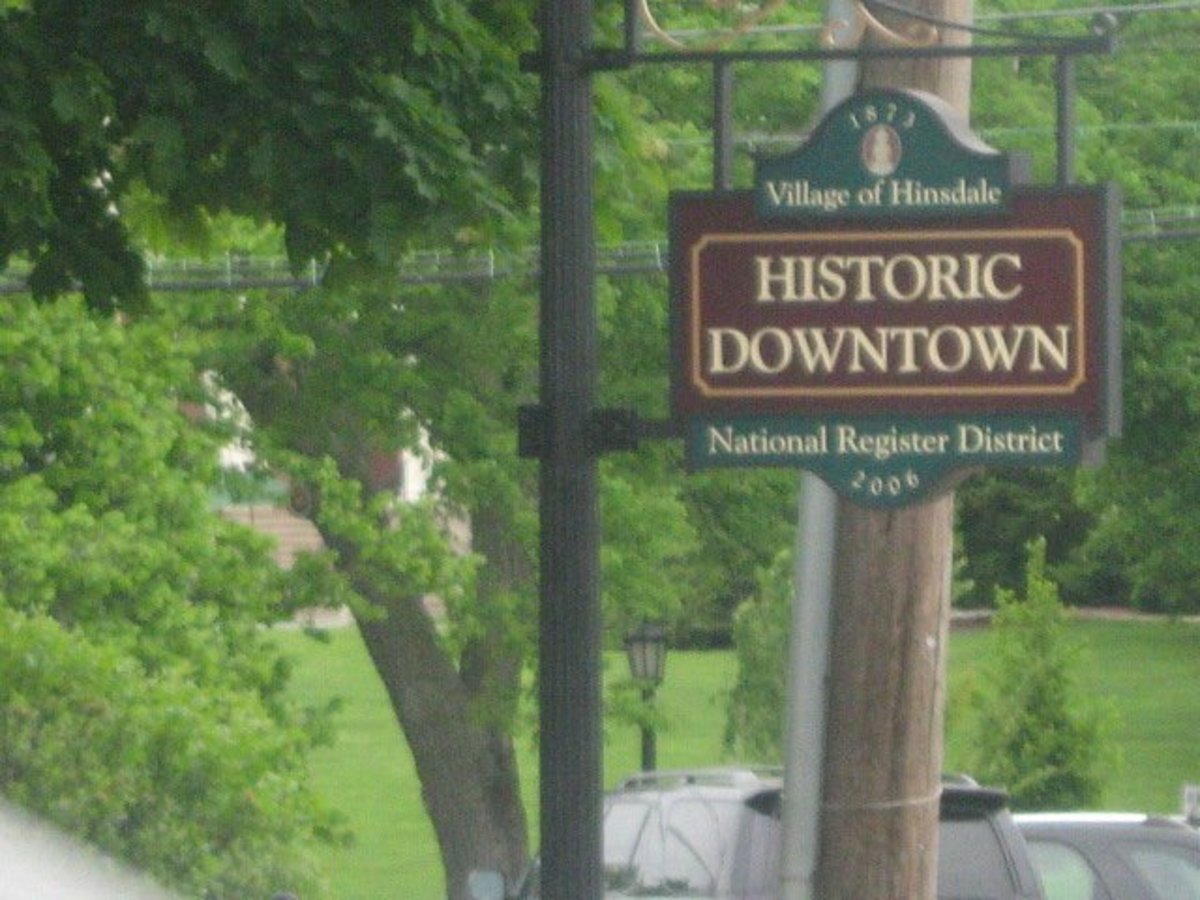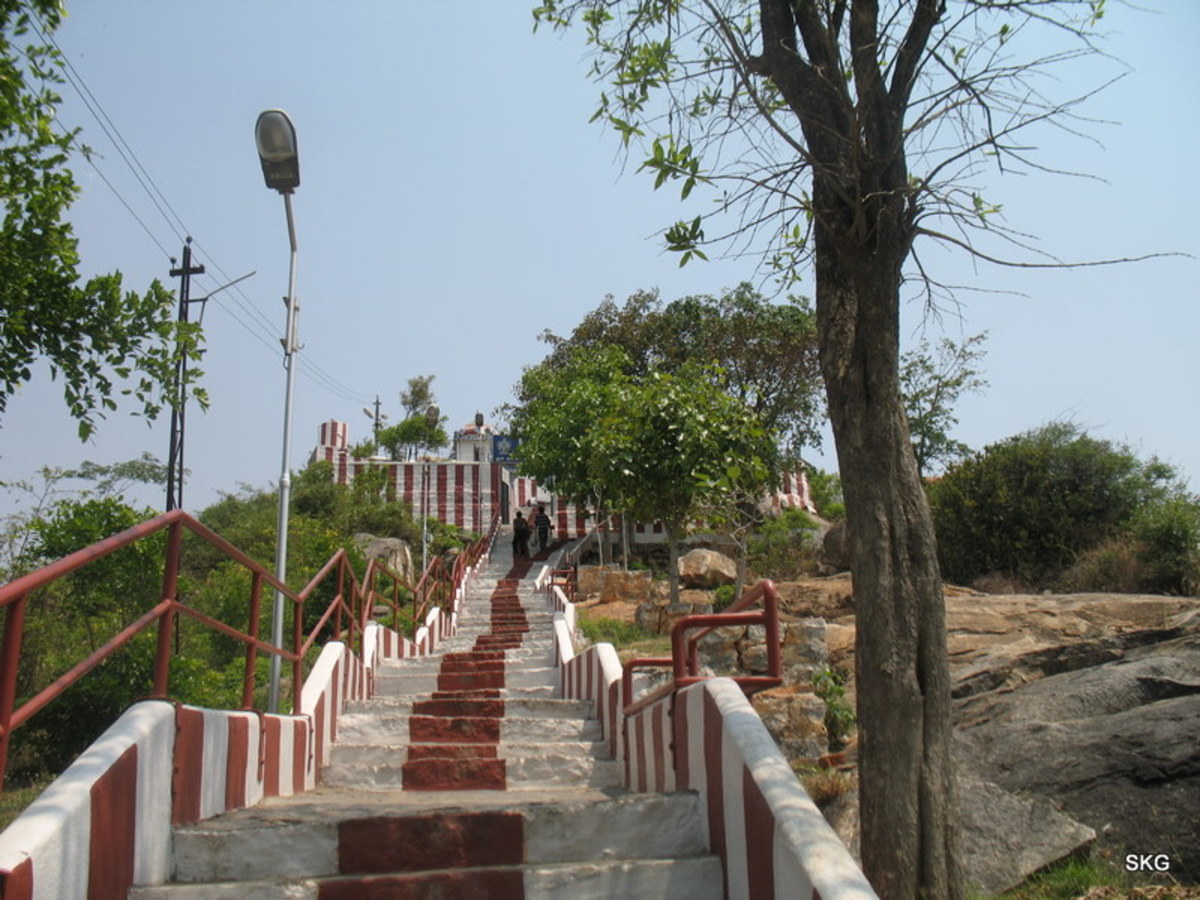A Single-Handed Passage Through The Night
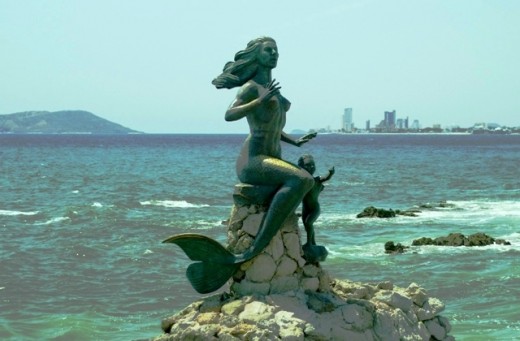
Testing my limits of endurance...
An over-night, singlehanded passage on the open sea is never as easy or invigorating as I allow myself to believe it will be before I depart. If I didn’t beguile myself with expectations of fair winds, calm seas, warm days, and starlit, tranquil nights at sea, I would probably never undertake the adventure. But all of that does occur, and so I tend to remember and focus on the positives without bemoaning the potential and inevitable hardships.
The passage I had planned this day would be made even more difficult by the lack of an operable autopilot and most of my electronic navigation instruments that had been taken-out by a lightning strike the month before. An insurance adjustor was waiting in Puerto Vallarta to assess the damage, but my vessel, sv Location, a Catalina 470 sloop, was sound; I had already replaced the depth and speed instruments, and I was capable enough to navigate without the luxury electronics that grace most cruising boats these days.
I had originally planned to hop down the coast from Mazatlan to Puerto Vallarta, sailing short distances during daylight, making nightly stops to anchor at open roadsteads, or an occasional cove if one could be found, taking my time and covering the 160 mile distance in a week or perhaps ten days. I motored the first hop, ten miles from the Marina Mazatlan in the Sabalo Estuary to the anchorage at Isla Piedras, southeast of the Port of Mazatlan, and then spent three days with a bevy of other cruising boats, who were also heading south, waiting for a good weather window. Truth be told, the day after I arrived at Stone Island the weather was perfect, but I was not that anxious to leave the beautiful city of Mazatlan, and so an excuse to hang around the area with other cruisers seemed a worthwhile diversion.
All of these other boats on their way south for the winter cruising season were crewed boats, in fact all six of them were being sailed by couples, most with three or four years of experience sailing along this coast of Mexico. Still they let me, the lone single-hander and relative newbie, be part of the group and we had a few beers and pizza together at Benji’s Palapa. Benji’s is owned by an expat couple who still live on their boat in the Isla Marina in the Sabalo Estuary of Mazatlan; their son is the head waiter and chief surfing advisor. The palapa sits on a pebbly sand beach on the northwest shore of the anchorage, with its grey frond thatched roofs like peasant hats perched on rough hewn logs and concrete posts stuffed precariously into the sandy earth. It overlooks a convenient little hook-cove beneath the rocky cliffs of Isla Chivos on the peninsula point that forms the east side of the Port channel. We talked of our plans for heading south to Banderas Bay, and to points beyond, and after a few beers and a scattered margarita or two, it was soon the consensus of the group that my strategy was flawed.
“There’s nothing between here and San Blas,” they all said. “And that’s an easy day and night trip when the wind is good.” They came up with other reasons as well, why they had never done it: “too many fishing boats and long-lines in close to shore; the cruising guides said there was nothing to do, no towns, no anchorages, no reason to go that way, or go that slow”. Besides the fishing boats and long-lines, none of their reasoning daunted my plan. I had sailed the Sea of Cortez for years, and anchored along open shorelines on the coast of Baja with few problems, but they soon had me thinking again of making another overnight passage. The wind would be good, the seas would be calm, the night would be sublime; the vision cajoled me.
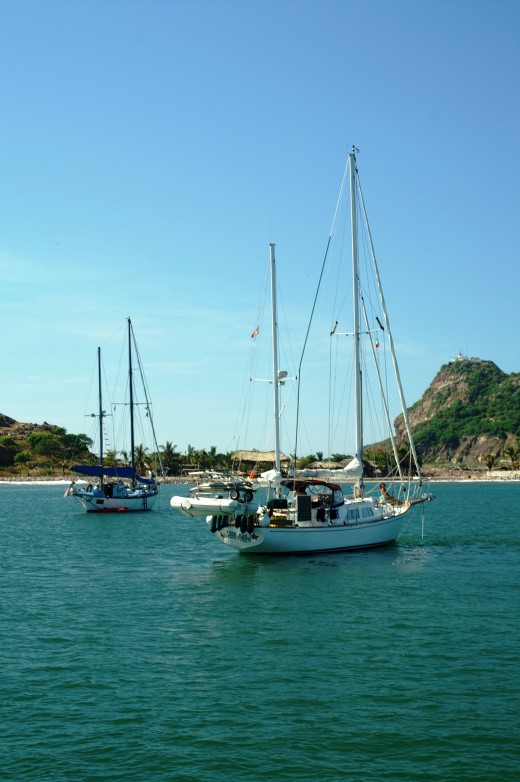
Monday the sky was overcast creating an invisible horizon with no wind in sight, but Tuesday morning the rising sun burned quickly through the morning haze and a steady breeze picked up from the north. The forecast on the weather net was for moderate NNW winds through the night, and with still a little trepidation in my soul, I was up early and resolved to make the fifteen to twenty hour passage south to Isla Isabella. The other boats in the anchorage were making ready as well with destinations of either Isla Isabella or further south to San Blas on the mainland coast. By ten-thirty I had my sails up and motor-sailed off the hook, turning south to a heading of 145 degrees / magnetic, on a rhumb line course to Isla Isabella. I motor-sailed for two hours, making fresh water from the clear blue sea, and charging Location’s batteries to ensure that we would have ample power for running lights through the long coming night.
The wind built through the morning and early afternoon as we sailed a comfortable broad-beam reach angling away from the coast at six knots. The sea transformed itself from dirty green to azure blue as we sailed out to deeper water, and the wind filled Location’s sails against the clear blue sky, shaking out the dusty creases in her cloth and lines that had set themselves during her three month summer layover in Mazatlan. It was a marvelous day, exactly as I envisioned it might be, and I was happy to be back out and sailing on the open water, though I knew the long night ahead would not prove quite as easy.
By two o’clock I was more bored than tired with steering Location, and attached two heavy bungees to her twin wheels which stiffened her rudder and held her steadier on course for short periods of time in the steady breeze and calm seas, and allowed me momentary breaks in the concentration on that duty. I also rigged a system of light block and tackle using spinnaker sheet blocks attached at the rail and some half-inch line attached to the spokes of each wheel and led forward to the cockpit under the dodger. This I hoped would allow me additional freedom from the helm as I could steer in a manner then from under the dodger where the mainsail sheet and reef lines were located, and make quick trips below to prepare a snack, or some other quick chore. It was not nearly as effective as the autopilot or a wind vane would be, but in light seas and wind with the sails properly trimmed and balanced Location would hold her course for a minute before a tweak on the rudder was needed. With her heavy fin keel and large spade rudder, she wanted to crawl up on the wind when left to her own, and the quartering seas had a tendency to push us that way as well, so she still required regular attention and correction in her course. The block and tackle steering system worked relatively well, and I could sit in the shade of the dodger facing back, and holding the lines like the reins of a horse, keep the boat relatively tight on her course by steering a reciprocal course on the compasses that I could see in the binnacles in front of each wheel looking back from my forward seat.
As the wind and seas built through the afternoon the slack time diminished, and by dusk with the wind blowing at probably fifteen knots or more, though I couldn’t know for sure since I had no wind instruments, and the seas then with a three foot swell, and Location rolling along at more than seven knots, the boat required more attention at the helm to maintain her trim and stay on course. With no chart plotter or other electronic navigation tools other than my hand-held GPS, I had planned to take intermittent GPS coordinates and plot them on paper charts to keep track of our course, but as darkness, and heavier seas, descended upon us this task became more difficult. The hand-held GPS was a new device to me and I was concerned about the battery life, and decided to use it only intermittently depending more on the compasses to hold our course. In the dark and hurried situation that I was in though I made several mistakes plotting our positions, and finally after being forced to re-plot our position on my chart several times I decided to use the hand-held as a constant course plotter, giving up on the cumbersome paper chart plotting altogether. It was too difficult to manage the plotting and steer the boat at the same time. I was starting to realize that the night’s passage without the aid of an autopilot or another set of hands would be more difficult than I had envisioned.
Eight hours into the passage we were half way to Isla Isabella and I set the island coordinates into the GPS as our final destination, and then adjusted our course and sail trim, leaving the helm for brief spurts of time to adjust the mainsheet, then back to the helm, then adjust the jib sheet, then back to the helm, then quickly forward to adjust the boom preventer, and then the mainsheet, and then quickly back to the helm to keep the boat from rolling up on the wind. Steering was a constant focus; everything else had to be done in thirty second bursts of energy. As it got dark and the air took on the evening chill, I dove below and grabbed a pair of Levis and a sweater, and then raced back up to the helm, holding the boat on course with one hand and dressing with the other. I made my dinner the same fitful way, reheating a piece of chicken, green beans, and half of a baked potato in the microwave; one trip below to get the container ready, then back up, another dash below to start the microwave, then back up, three minutes latter back below to start the micro wave again for another two minutes, then back up to the helm, then back down to grab the hot food and a fork, and back up, and finally half out of breath and steering with my feet I ate dinner at the helm as we pushed through the dark sea. The food was wonderful and revived my spirits, but I soon accepted that I was no longer enjoying myself; the passage had then become a test, as I had always known it would.
The night air grew heavy and cold with dew. I made another dash below to get my foul-weather jacket, and then back up to man the helm. There was no moon and the stars were thick and bright in the ebony sky casting a pale silvery sheen on the rolling sea. Except for the cold and wet it was a beautiful night, and Location cut easily through the rippling sea leaving a phosphorescent wake of broken water behind her. At times I could hear dolphins moving along with us blowing air as they broke the surface, and I would catch a glimpse of their ghost scooting along beside us just below the surface or a fin cutting a pearlescent trail in the water. They would leave and then another pod would materialize out of the night an hour later, and play on Location’s bow in the dark for a while.
It was a long night and I wanted to sleep, and I would close my eyes for a couple of seconds and the boat would start to drift, and I would feel the wind change on my face or the sails would slat, and I would shake myself awake and bring her back on course. I saw other boat lights at times, even on the vast open sea we plied forty miles out from shore. A cruise ship closed on us at one point, growing from a distant spot to a city of lights. I was not concerned at first, but we held a collision course as we got closer, and I remembered then that I had no radar, and not only could I not tell how far away they were they could probably not see me. I altered course to pass behind them, and then they stopped and circled in the middle of the sea as cruise ships do at times at night, and I altered course again to pass in front of them, I hoped. We did clear them, but no more than a half mile apart, which given the vastness of the sea is too close for comfort at night.
The waning moon came up later rising out of the darkness like a crystal bowl of light as we moved into the next day. The Big Dipper hung in the northeast sky, its handle pointing to the grey fringe of the horizon, and another set of boat lights began to close on us from the west. These were sailboat lights. The red masthead light was clear and the stern light white bounced into view as they grew closer off my starboard beam. We were again on a collision course with a boat in the middle of an empty sea, but the approaching lights changed as we closed, and red went to green and the white stern light swung around in the darkness, and I could see the faint silhouette of a sail in the pale moonlight. The other boat had altered course, and then out of the darkness a voice on channel 16 hailed a vessel at our latitude and longitude. I checked the GPS to confirm our location and then responded. The boat was the ketch “Odle” and they were sailing with a spinnaker and pole, and asked if I could point up “just a bit higher on the wind” so they could pass easier behind us. I acknowledged and turned up into the wind a few degrees, and Location spurted forward. We passed and I watched as our lights separated and then disappeared in the night.
Morning came grudgingly, rising grey and wet and slowly from a heavy haze upon the sea. The GPS showed that we were within five miles of the coordinates of Isla Isabella that I had hurriedly entered the night before. I saw several islands southwest of us and checked my charts as I struggled to hold Location to her course. I checked our latitude and longitude again, and the charts, and looked again at the islands on the horizon. They were not Isla Isabella. We had sailed past Isla Isabella, and these islands were the three prison islands of Islas Marias. I had set the wrong coordinates, and we were twenty miles southwest of Isla Isabella, twenty miles past my intended mark; another three or four hours of sailing if I changed course immediately, if the wind held. I could see it then, a small peak of rock rising on the northeastern horizon as the sun broke free of the haze, and cast a morning glow of orange upon the day.
I went forward on deck then and released the main boom preventer, and then back to the helm, and then forward to the jib and main sheet winches in the cockpit, and back to the helm, and brought the boat up and through the wind, tacking her sails, handling the three sail sheets and the helm together, and then setting her on course northeast for the island. The warmth of the sun began to warm my day and revive my spirits, but I was perturbed that I had sailed past my mark.
Three hours later we approached the island from the south, and the wind started to flag. I furled the jib and sheeted in the main and started the engine to motor around the east side of the island where the anchorages were. Two other boats were coming in ahead of us from the north. It would do no good to race, but I was tired and wanted to anchor and rest, and I hoped that there would be room left in the small island anchorages.
As we rounded the southeast point of the island I could see that the south anchorage was full, already with more boats than usual in the cove. One of the other incoming vessels had found space to anchor, and the remaining boat was turning out and heading north for the other anchorage at Las Monas (The Mannequins). I followed to see if there was any hope there. It was full as well though, and so I turned and set my heading for San Blas, another forty miles of sea to cover. The seas were flat and the wind had dropped to nearly nothing, and so we motor-sailed away from the little island as the morning warmed from the rising sun.
A couple of Grey Whales greeted me as I headed east toward the mainland coast. They appeared to be a mother and baby and were moving across my path, so I slowed to allow them room to pass. The mother dove then and an instant later, less than a thousand feet from my bow, she breached flying nearly completely out of the water, and twisting in mid-air, and landed with a heavy spectacular splash. She disappeared for a moment, with the baby still moving slowly on the surface, and then suddenly she breached again, another spectacular leap in the air and a crashing dive to the sea. The baby disappeared in the froth, and then it made a newborn attempt at mimicry, coming barely half out of the water, and then the mother reappeared on the surface with a great blow of air and water, and the two moved on across my bow, done with their play for the moment at least. I remembered then why these passages never seem so impossible before I go.
The coastal mountains darkened on the horizon as we approached, with tall billowing clouds of grey and white rising above the peaks. The wind picked up later as noon approached, and I set all the sail aloft and shut down the engine after several hours of motor-sailing. I gained a second wind myself, daylight holding my fatigue at bay, and San Blas was in view as dusk descended on the sea. We were still tens miles from the harbor and the city, but with darkness coming on quickly I furled the headsail and dropped the main, and then proceeded on under motor toward the emerging lights on shore.
It was eight o’clock by the time I identified the harbor entrance lights of San Blas, and since the channel had an infamous shoal guarding its entrance, and fatigue was quickly clouding both my vision and my judgement, I decided to head for the open anchorage at Matanchen Bay, some four miles past the harbor channel. Without radar or a chart plotter to define my position, I struggled with the paper charts and cruisers guide book, trying to identify land marks in the dark. I could hear the surf breaking on the shore, and see the silvery curl and crest of the breaking waves as we motored along, following the contours of the sea bed on the depth sounder, making sure to stay in at least twenty-five feet of water on the shallow coast. This was all new territory for me and the open waters of Matanchen Bay were hidden in my fatigue and in the lights along the coast. I began to see flashing lights, and channel markers, and then an island rock in front of me, none of which existed on the charts or guide book, and I started to realize that fatigue was causing me to imagine obstacles that didn’t exist; I was starting to hallucinate. I was close to the bay, but nothing was clear, and every dark spot between the lights on the horizon appeared to be a rock or other potential menace. I was in twenty feet of water then, in a gentle swell, and I stopped, and dropped the anchor, too tired and unsure to proceed. I made a peanut butter and jelly sandwich for dinner, I was famished, and crashed in my berth, exhausted.
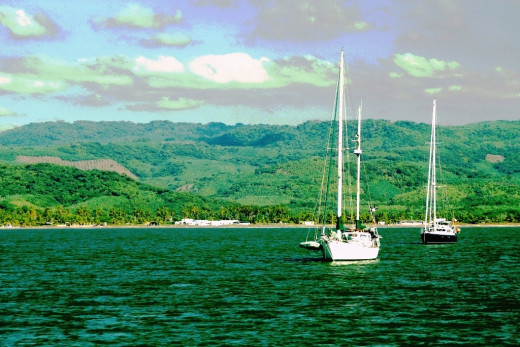
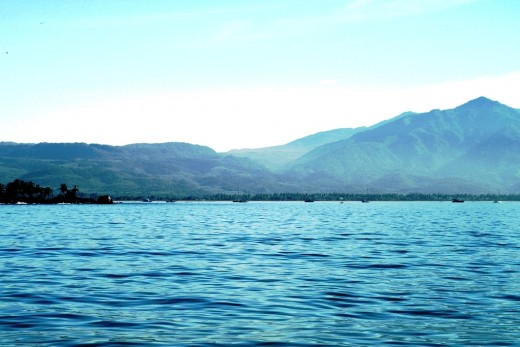
In the morning I woke to bright sunlight and an easy swaying swell, still hearing the wash of the surf on shore. I had done well; we were anchored a thousand feet off the palm lined northwest point of Matanchen Bay, and I could see a small fleet of other cruisers anchored a mile away inside the bay. Just a couple hundred feet away, anchored next to me on the port beam, was the ketch Odle, that the night before I had taken for an island rock, and a hundred feet off our starboard beam were several rows of buoys holding a series of long-line fishing lines; a potentially ugly snare of line and wire I had barely managed to avoid in the night. Odle pulled up anchor first and headed into the bay, and I followed an hour later, skirting the field of fishing lines and buoys, after a breakfast of coffee and cereal.
